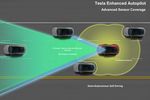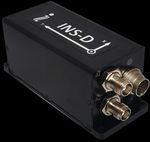Inertial Labs' Expertise in PNT and Sensor Fusion Paves Way for Level 5 Autonomy
←
→
Page content transcription
If your browser does not render page correctly, please read the page content below
Level 2
Autonomous Vehicles Level 2 automation dictates the use of an advanced
driver assistance system (ADAS). An ADAS can
control both the steering and the acceleration or
Autonomous Vehicles have long been viewed as deceleration of the vehicle. Using a human-
the logical next monumental breakthrough in machine interface, an ADAS improves the driver’s
engineering. A fantastical feat that has been ability to react to dangers on the road through
depicted throughout Hollywood and analyzed by early warning and automation systems. An ADAS
many journals; autonomous vehicles are one of the utilizes a series of high-quality sensors, cameras
most highly scrutinized potential breakthroughs of and LiDAR to provide 360-degree imagery, 3D
this decade. There are 6 levels of autonomy which object resolution, and real-time data. Some
represent a progressive pathway to level 5 – full features of an ADAS could include Anti-lock brakes,
autonomy. So, this begs the questions: How long forward collision warning, lane departure warning,
until we reach complete autonomy? What level of and traction control. Some currently implemented
autonomy are we at now? And how is it examples of level 2 autonomy include Tesla
accomplished? First, let’s get a clear picture of what Autopilot and Cadillac Super Cruise systems.
each level of autonomy entails.
Levels of Autonomy
Level 0
Industry Analysis
This level represents a complete lack of autonomy
– manually controlled vehicles. The human is
responsible for the “dynamic driving task”, but
there can be a few systems in place to aid the
driver. The “dynamic driving task” refers to the real
time operational and tactical functions required to
operate a vehicle in on-road traffic. Systems that
do not “drive” the vehicle, such as an emergency
braking system or standard cruise control, do not Level 3
qualify as autonomy and are therefore considered
level 0 systems. Many vehicles that are on the road Vehicles that have environmental detection
today operate at level 0 autonomy. capabilities and can make informed decisions
themselves are considered level 3 autonomous.
While having these features, these vehicles still
Level 1
require human intervention if unable to execute a
The lowest level of automation, level 1 task. The Audi A8L was set to hit the road with
autonomous vehicles feature a single automated level 3 autonomous technology. It’s Traffic Jam
system that provides the driver assistance. Pilot combines a lidar scanner with advanced
Adaptive cruise control, where the vehicle can be sensor fusion, processing power, and built-in
guided and kept at a safe distance behind the next redundancies. That being said, global regulators
car, is a popular example of level one autonomy. had yet to agree on an approval process for level 3
These systems vary, but typically use some vehicles, forcing Audi to abandon its level 3 hopes.
combination of LiDAR, radar, or camera to This was until the Honda Legend got the worlds-
automatically accelerate or brake to keep the first approval for level 3 autonomous vehicles in
vehicle at a safe distance from the vehicle ahead. Japan with its own Traffic Jam Pilot automated
Many newer car models that have implemented driving equipment.
this system qualify as level 1 autonomous vehicles.Level 4 is more accurate than data from the sensors alone.
To learn more about sensor fusion and the Kalman
The main improvement between level 3 and 4 is Filter, check out our white paper here.
that level 4 vehicles can intervene themselves if
things go wrong or there is a system failure. With
this ability, these cars do not require human
intervention in most situations. However, the
Sensor Fusion in Autonomy
human still has the option to manually override the Advanced Driver Assistance Systems
vehicle. In the future, level four vehicles are (ADAS)
expected to be used for ride-share and public
transportation purposes. Many present vehicles with ADAS utilize
information from different sensors such as radar,
optical cameras, LiDAR, or ultrasound. Sensor
Level 5 fusion can be used to combine information from
Perhaps the hottest topic in engineering, level five these sensors to provide a clearer view of the
vehicles have full driving automation and do not vehicle’s environment and is integral in the
require human attention. These vehicles will not advancement of these systems. A common example
have typical driving components such as steering of sensor fusion in ADAS is the fusion of
wheels or pedals. While there has been testing for information between a front camera and radar.
level five vehicles, none have been available to the Alone, both sensors have issues in environmental
general public. detection. A camera has problems in conditions
Industry Analysis such as rain, fog, and sun glare, but is a reliable
Recently, the timetable for level five autonomy has source of color recognition. Radar is useful for
become murky with many automakers backing off detecting object distance but is not good at
on their claims of having level five vehicles recognizing features like road markings. Sensor
available between 2018 and 2025. With very few fusion between a camera and radar is found in
cars approved for public level three autonomy, it Adaptive Cruise Control (ACC) and Autonomous
seems likely that there is still room for innovation, Emergency Braking (AEB) These are a couple
and it will likely take a decade before level five examples of ADAS features that are found in many
automation is achieved. newer car models.
Sensor Fusion in
Autonomous Vehicles
Sensor Fusion
Sensor fusion is utilized in a variety of systems that
need to output estimated data based on the raw
data from multiple sensors. Sensor fusion is the
Autonomous Vehicles
ability to bring together multiple sensor inputs to
produce a single result that is more accurate than As noted earlier, a major advantage of sensor
that of the individual inputs alone. A popular fusion in the frame of autonomous vehicles is that
example of sensor fusion is the Kalman Filter. A the combined data from various sensors can
Kalman filter utilizes a series of observed overcome the environmental shortcomings of
measurements over time, filters out naturally individuals sensors. As a result, this reduces false
occurring statistical noise and other inaccuracies, negatives and false positives, while increasing the
and produce a weighted estimate that overall performance and reliability of the system.The importance of sensor fusion is highlighted This means that the camera images are projected
most in the path planning aspect of autonomous over the georeferenced LiDAR data, so each point
vehicles. Here, sensor readings are integrated to is colorized to reflect the color of the point in the
provide precise analysis of the vehicle’s state and real world. This is especially important for object
predict the trajectories of the surrounding objects. detection and feature recognition such as road
This allows the vehicle to perceive its environment lines.
more accurately, as the noise variance of a fused
sensor is smaller than the variance of individual
sensor readings. Real World Applications
Virginia Tech
Inertial Labs has partnered with the Autonomous
Systems and Intelligent Machines (ASIM) lab in
the Mechanical Engineering department of
Virginia Tech to conduct research on Connected
and Autonomous Vehicles (CAV). Students are
using the INS-D, along with other various sensors,
to convert a hybrid sedan into an autonomous
car. The ASIM lab was established with the
purpose of conducting research on autonomy
from a dynamical systems and intelligent controls
Inertial Labs Involvement In perspective. Through a combination of sensor
fusion techniques, connectivity through
Autonomous Vehicles communications, and advanced learning
algorithms, the ASIM lab has developed
intelligent machines such as autonomous or semi-
Inertial Labs INS-D in autonomous robots and vehicles.
Autonomous Navigation
Industry Analysis Robotics Plus
The Inertial Labs INS-D is an Inertial Navigation
System (INS) that uses data from gyroscopes, Robotics Plus has developed a line of unmanned
accelerometers, fluxgate magnetometers, a dual ground vehicles (UGV) for precision agriculture
antenna GNSS receiver, and a barometer. This data applications. Inertial Labs’ Inertial Navigation
is fed into an onboard sensor fusion filter to System, fused with optical aiding data, can
provide accurate position, velocity, heading, pitch, produce real-time georeferenced data. When fed
and roll of the vehicle under measure. The INS-D, into a robust algorithm, this allows the UGV to be
fused with aiding data from LiDAR, optical cameras, aware of its surroundings. Designed due to the
or SONAR, can provide the necessary data for demand to mechanize orchard and horticultural
object detection or simultaneous localization and tasks, these UGVs are continuously being
mapping (SLAM) algorithms. For example, the INS- developed to be applied to a range of applications
D, combined with LiDAR and optical camera data, in varying environments. Robotics Plus was made
can produce georeferenced and time stamped data with the purpose of solving the increasingly
for vehicle navigation that is accurate within a few pertinent agricultural challenges of labor
centimeters. Georeferenced data is data that is shortages, crop sustainability, pollination gaps,
related to a geographic coordinate system, so this and yield security. An award-winning innovative
data has a precise location in physical space, which company, Inertial Labs is proud to work with
is crucial for mapping a vehicle's environment. Robotics Plus in their continued goals of
Additionally, sensor fusion of the optical camera improving grower experience and their yield
allows for this data to be colorized. security.Pliant Offshore
Heading 2
Pliant Offshore are experts in offshore
measurement and control combined with 3D
software technology. Inertial Labs has worked
with Pliant Offshore to aid them in their goals of
producing accurate products that can withstand
harsh environments and produce precise results.
Inertial Labs' inertial technology is used on
their unmanned surface vessels (USV) to track and
trace assets, review asset history, and monitor
wear, usage, and lifetime of assets. USVs can use
Inertial Labs' Motion Reference Units (MRU) fused
with a multi-beam echo sounder (MBES) to
inspect assets with accurate, georeferenced data
and monitor these assets over time. With a
mission of developing and improving products to
maximize time-efficiency, cost-effectivity, and
safety for end-users, Inertial Labs is excited to
GPS-Aided INS-D
continue working with Pliant Offshore.
Specification Performance
0.08 deg
Dynamic Heading Accuracy
(2-meter baseline)
Dynamic Pitch & Roll 0.08 deg
Position (RTK) 0.01 m + 1 ppm
0.05% DT with Odometer
GPS Denied Navigation
0.02% DT without
Accuracy
Odometer
What Do Here at
Inertial Labs,
You we care
GNSS Receiver Type Dual GNSS Antenna
MEMS
Think? about our IMU Grade
Tactical Grade
customers
Size 120 x 50 x 53 mm
satisfaction and want to continuously be
able to provide solutions that are Weight 320 grams
specifically tailored to problems that are
Contact Information
occurring today, while vigorously
developing products to tackle the problems Address: 39959 Catoctin Ridge Street,
of tomorrow. Your opinion is always Paeonian Springs, VA 20129 U.S.A.
important to us! Whether you are a Website: www.inertiallabs.com
student, an entrepreneur, or an industry
heavyweight. Share your thoughts on our
products, recommendations you have, or
just say hello at opinions@inertiallabs.com.
Trademark Legal Notice: All product names, logos, and brands are property of their respective
owners. All company, product and service names used in this document are for identification
purposes only. Use of names, logos, pictures, units and brands does not imply
endorsement of Pliant Offshore, Robotics Plus, Virginia Tech, Audi, Honda, Cadillac, and Tesla.About Inertial Labs Inc.
Established in 2001, Inertial Labs is a leader in position and orientation technologies for commercial,
industrial, aerospace and defense applications. Inertial Labs has a worldwide distributor and representative
network covering 20+ countries across 6 continents and a standard product line spanning from Inertial
Measurement Units (IMU) to GPS-Aided Inertial Navigation Systems (INS). With application breadth on
Land, Air, and Sea; Inertial Labs covers the gambit of inertial technologies and solutions.
Inertial Labs, Inc.
39959 Catoctin Ridge Street,
Paeonian Springs, VA
20129 USA
phone: +1 (703) 880 4222
sales@inertiallabs.com
www.inertiallabs.comYou can also read


























































